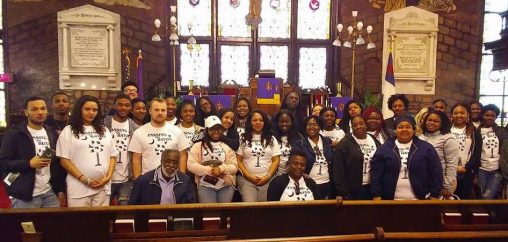
During the 2016 Civil Rights Pilgrimage, Wright State students visited the historic Mother Emanuel AME Church in Charleston, South Carolina, where nine people were killed in 2015.
During Wright State University’s spring break, 40 students are heading south — but not for the beaches. They’ll make a pilgrimage March 5-9 to historical sites associated with the civil rights movement, while examining a crucial phase of America’s past.
The Civil Rights Pilgrimage has become an annual alternative to spring break at Wright State. The itinerary this year includes landmarks in Montgomery, Alabama; Jackson, Mississippi; and New Orleans.
A third of the students are participating as part of a spring semester class taught by Tracy D. Snipe, professor of political science in the School of Public and International Affairs in the College of Liberal Arts. However, the trip is open to any student who wishes to go. Past participants have included international students, community members, faculty members and staff members, as well as sponsors such as Kristin Sobolik, former College of Liberal Arts dean, and previous administrators.
Snipe personally created the pilgrimage and has led the group for seven years.
Nycia Lattimore, assistant director of the Bolinga Black Cultural Resources Center, helps administrate the program and guide the group. Private funding from philanthropic groups and individuals help make the trip possible.
“This year, we’re focusing on the youth and how they have impacted the civil rights movement in the past and still have a platform today,” said Snipe. “Students are very excited this year and we have a record number going on the trip.”
With the increase in youth activism across the country in recent years, Snipe chose a relevant theme, The Children’s Crusade and the Civil Rights Movement: Living the Dream, Ensuring the Legacy.
Snipe noted that most students of history can identify Martin Luther King Jr., Rosa Parks and Malcolm X and describe their contributions to civil and human rights, but may not be familiar with events like the Birmingham Children’s Crusade of 1963 and the significance of the lives of children such as Emmett Louis Till, Claudette Colvin, Clarence Norris, Linda Carol Brown, Junie Collins Williams, George Stinney Jr. and Ohio’s Tamir Rice to past and ongoing civil rights struggles.
The upcoming pilgrimage focuses on the drive that young people added to the movement in the past, as well as present manifestations, such as the Black Lives Matter movement and the Children’s Crusade in Florida that followed the mass shooting at a high school in Parkland, Florida, last year.
“It makes history living or more real when you can be in the places where history happened and actually meet civil rights icons,” said Snipe.
To make the experience more meaningful, students have created a private blog where they can share their reflections with one another.
This year he has planned a special dinner reception with Sarah Collins Rudolph, a survivor of the 16th Street Baptist Church bombing that killed four little girls in Birmingham in 1963. She was only 12 years old at the time of the attack and suffered severe injuries. Her sister Addie Mae, who was only a few feet away, was one of the victims. Snipe has written a biography of Collins Rudolph called “The Fifth Girl.”
Other sites of interest include the National Memorial for Peace and Justice, the nation’s first memorial to victims of lynching, and related Legacy Museum, which focuses on mass incarceration. Students also will tour the new Mississippi Civil Rights Museum, which opened last year in Jackson, the Ruby Bridges Memorial and Congo Square in New Orleans and the Whitney Plantation in Edgard, Louisiana.
“Over the last seven years, we’ve visited numerous places that are pillars of the civil rights movement such as Central High School in Little Rock, Arkansas,” Snipe explained. “This annual pilgrimage makes Wright State’s programming comparable to major universities across the country that have civil rights programs or feature pilgrimages.”

 Wright State alum Lindsay Aitchison fulfills childhood space-agency dream
Wright State alum Lindsay Aitchison fulfills childhood space-agency dream  Wright State business professor, alumnus honored by regional technology organizations
Wright State business professor, alumnus honored by regional technology organizations  Wright State University Foundation awards 11 Students First Fund projects
Wright State University Foundation awards 11 Students First Fund projects  Gov. DeWine reappoints Board Treasurer Beth Ferris and names student Ella Vaught to Wright State Board of Trustees
Gov. DeWine reappoints Board Treasurer Beth Ferris and names student Ella Vaught to Wright State Board of Trustees  Joe Gruenberg’s 40-Year support for Wright State celebrated with Honorary Alumnus Award
Joe Gruenberg’s 40-Year support for Wright State celebrated with Honorary Alumnus Award 